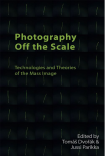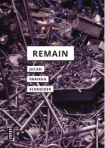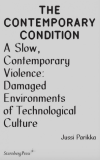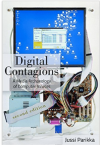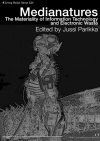Archive
New Czech titles
Now published in Czech, two closely connected books: the translation of What is Media Archaeology? (transl. Michal Šimůnek) and Martin Charvát’s book about my work Jussi Parikka: Od archeologie ke geologii médií (“Jussi Parikka: From Media Archaeology to Geology of Media”). Very excited and grateful to both of them for their work, insights, and careful attention.

The publisher is NAMU press.
Below a short glimpse of the interview we did with Martin for his book (note that the original English discussion has not been tidied so please excuse any minor language hiccups).
<M. C. As I see it, in your work there is a strong tendency present: from the analysis of „dark sides“ of digital culture to geology of media, to the (on the one hand) abstract but strictly material frameworks (or empirical conditions of possibilities) of contemporary digital culture based on using (in a sense of dependency) material from Earth, and to the (on the other hand) urgent need to look at these phenomena through (to put it in Deleuzean terms) “geology of morals”, which transcends a priori critique of technique, and thematizes the usage or cultural techniques emerging in contemporary society and connect them with geo-political climate.
J. P. I was originally trained in Cultural History (in Turku, Finland) which was great background education to consider the broader historical contexts of contemporary culture. It was also a context where I had to do extra work in figuring out how I can continue my theoretical interests while engaging in historical methods. One line of thought that cuts across those themes, those tendencies, is that I am interested in the anomalous, whether that is in relation to the dark sides and accidents of technological culture or in terms of the alternative methodological and conceptual angles that unfold a different perspective. The Deleuzean impact was early on really important for me – I still remember well the course on Deleuze (and a bit on Guattari) that professor Jukka Sihvonen gave in Turku and that I attended together with my friend, media scholar Pasi Väliaho. It was an eye-opener. I did not know how to place it exactly in terms of my other studies but it crept into some work I did in Finnish (including a book that was published in Finnish, Koneoppi) and then to some themes in Digital Contagions that was also my doctoral project that later turned into a book. Another influence was Friedrich Kittler, also introduced by Sihvonen, and whose work then became a different way of trying to start thinking questions of materiality which led into discussions also in new materialism from a much more material feminist position. Rosi Braidotti’s seminars in 2005 were another eye opener.
But in terms of the theme of the anomalous – it does not necessarily mean even marginal. Just that from Digital Contagions to later work, I was trying to come up with questions that are not necessarily at first obvious; conceptual twists that offer different perspectives while building on existing theoretical and scholarly traditions, but also rhetorically are able to frame a different way of understanding those conceptual entities inside “media studies” but also way outside it.
The geopolitical that includes Earth energies is far from marginal but I felt a necessary way to continue the link between conceptual work, extended media studies perspectives, and burning contemporary topics. I was trying to avoid it being merely a contribution to the Anthropocene debate about this new geological period defined by industrialism, synthetic chemistry and massive scale of agriculture, the nuclear age and mass exterminations of multiple kinds – including as many have pointed out, colonial time scales – and think of ways how the question of materiality can be placed in questions of ecology. Geology of morals turns into a Robert Smithson inspired large-scale, landscape-scale changes impacted by media and technological culture that also challenges models of agency and definitely forces non-anthropocentric perspectives both in analysis and in coming up with ethical solutions. To riff with Braidotti’s ideas: it was the ideal of the human in the modern Western humanism that got us into a lot of trouble with its colonial human (able-male) centric ways of organizing worldviews; now we are in the midst of a larger transformation where other questions have to be brought forward for a more radical sustainable future.
[…]
M. C. Currently you are the head of GAČR EXPRO project at Prague Famu. Could you elaborate please a little bit about the topic of the research? (Operational images)
J. P. Operational images is a concept that stems from the filmmaker Harun Farocki’s work and investigations. Already in his work in the 1980s and 1990s he mapped visual forms of measurement and rationalization of the world in relation to political history, violence, holocaust, and industrial scale violence although the concept emerges in a more articulated form in the Eye/Machine video series of installations between 2000-2003. While Farocki’s work is interesting as such – in how it articulates themes of proximity/distance, visuality/calculation, war/media – our project picks up on the concept itself: operational images as images that function primarily as part of a (technical) operation like in the case of self-guided missile systems, machine vision systems, robotics, etc. The concept has had a vivid afterlife following Farocki and it pops up in use by theorists and artists such as Hito Steyerl and Trevor Paglen, as well as in works by many of the colleagues in media studies etc., but we are interested both in how to use it as a concept to outline alternative histories of photography and visual culture and to open up new questions in contemporary contexts of art and visual theory.
For example, I am working with Abelardo Gil-Fournier on outlining questions of vegetal materiality and visual culture, from late 19th century plant physiology and framing of photosynthesis to broader scales such as in Vladimir Vernadsky’s take on the planetary biosphere. We are interested in how from questions of photography and visual culture we can outline a take on operational images in scientific contexts, planetary scales of plants and agriculture, and this refurbishing of the planet by way of terraforming that has taken place for example indeed in agriculture.
Of course the project incorporates more than that. Tomas Dvorak’s investigations into photography as measurement is one insightful way of dealing with the overlap between methods in history of science and media; previously, our conference theme was on Expert-Readable Images expanding the idea of machinic agency of images (Machine-Readable) to the work of experts and specialist practices too. Also our book Photography off the Scale that came out in 2021 with Edinburgh University Press included contributions from our project team on the question of measure, scale, and quantity in photographic culture.
The book Operational Images. From the Visual to the Invisual is forthcoming from University of Minnesota Press in 2023.
O que é a arqueologia das mídias?
The Portuguese (Brazilian) edition of What is Media Archaeology? came out as a translation published by Eduerj (Rio de Janeiro). O que é a arqueologia das mídias? includes both the translation (thanks to coordinator Maria Alice G. Antunes) and two new texts accompanying the original; one by Erick Felinto, another by Adriana Amaral. A big thanks to everyone involved.

For those interested in recent Brazilian discussions on media archaeology, see here a recent interview we did with Alex Martire and Camila de Ávila. Includes Portuguese subtitles.
An interview on media archaeology with Brazilian colleagues
Thanks to Alex Martire and Camila de Ávila of the Grupo de pesquisa (CNPq) Arqueologia Interativa e Simulações Eletrônicas (ARISE), do MAE-USP (a Brazilian research group focused on archaeology & archaeogaming) for this interview on media archaeology, my own route into these topics, etc.
The conversation comes with Portuguese subtitles.
The timing is fitting as the Brazilian edition of What is Media Archaeology? should be coming out soon (published by EDUERJ).
Premio Limina 2020 // book award
I am extremely happy to learn that we won! The Italian translation of What is Media Archaeology? – Archeologia dei media – was awarded the XVIII Premio Limina in the category of “Best Italian Translation of an Important Contribution to Film Studies” (Miglior traduzione italiana di un importante contributo agli studi cinematografici). The translators Enrico Campo and Simone Dotto, and the editors and writers of Preface and Postface Simone Venturini and Ruggero Eugeni are the ones to thank and to congratulate for their work.
The book came out last year Autumn just when I was starting my visiting Professorship, Chair of Media Archaeology, at University of Udine; students and colleagues (including at the Gorizia’s La Camera Ottica) provided such a friendly and exciting academic environment in cinema studies where the book’s idea of “traveling media archaeology” was (again) realized in multiple ways: institutional and practice-based contexts, including practice of theory, where media archaeology travels.
All the winning books here alongside justification statements for the awards.
You can find the Italian version on publishing house Carocci’s pages, and the original English on Polity pages.
For Italian speakers, here’s an interview/text in Artribute about the translation.

A Performance of Exchanges
A review by Debra Levine of our book Remain (Ioana Jucan, Rebecca Schneider, and myself) has just been published in the Dance Research journal.
Quoting here the nice ending by Levine that notes especially the exchange between performance studies and media archaeology and ecology:
“This excellent volume offers methodologies in performance studies and media archeology to work with remains and relics as speculative objects and vestigial technologies. The text convincingly argues that their ongoing presence is not merely indexical to a foreclosed moment in the past, but instead, as Schneider writes, “a decay that just won’t quit” (73, quoted from Schneider 2012, 159). Their stubborn presence— the fact that remains are “scriptive things” (a term coined by Robin Bernstein to indicate their passage to and from biobodies; Berbstein 69), as well as interfaces—allows performance studies to play with media archeology and ecology as a performance of exchanges which revise the temporality and the materiality of the remain, and as Parikka notes, can be afforded a “liveliness of multiple afterlives” (43).”
The book is available from University of Minnesota Press as paperback and from Meson Press as Open Access download.
How to practice variantology of media?
I was commissioned to write a short popular audience piece on Siegfried Zielinski for the Korean article series “The Front Lines of the 21st Century Humanities and Social Sciences”. The series has featured many theorists from Kittler to Haraway, Barad to Latour, as well as one article on my work. The text on Zielinski is now published and I wanted to post the original English text (not copy-edited, apologies for awkward language hiccups) here. Please find it below. The short text was also written to note the just published volume of Zielinski texts, Variations on Media Thinking (University of Minnesota Press, 2019.)
Siegfried Zielinski: How to practice variantology of media?
One way to understand a theorist’s work is to look at how she or he is being talked about. What do your friends or enemies say? What are the concepts, ideas, or generic style of a theorist that catch wind and which ones are left to the side? While Siegfried Zielinski has become known for his significant work as one of the early theorists of media archaeology and as a poetic palaeontologist of deep times of art and science, it is curious to have a peek at the little book Objects of Knowledge – a Small Technical Encyclopedia that functioned as a Festschrift, a celebration of Zielinski’s 60th birthday, written by his colleagues and peers. In the eyes of his friends, Zielinski’s work extends to a whole glossary of odd objects, things, and speculations that reveals the influence he has had in extending the discussion of media to clearly things not usually considered media. A wild list of “media” objects constitutes the book’s entries: basket, bathtub, book destruction machine; Dried Food, Filmoscope, Fountain Pen, and Geiger Counter; Hand, Line, Phenakistoscope; Sardine Can, Side Scan Sonar, Slide Rule, Typewriter, and Wall Socket are some of the examples of where we end up when riding with Zielinski’s mind set. While Zielinski himself has recognized that perhaps media, as a term, has become superfluous, this also was one form of a liberating feeling: finally we are not stuck with only mainstream set of a focus on media as entertainment, media as pleasing viewers and customers.
In this manner, one would do justice to the broad career of the German media theorist and professor Zielinski by calling him a variantologist of media. True, he has mobilized a range of terms that speak about deep times and palentology of media, suggesting that our usual historical timeframe is not sufficient to understand the longer histories of art and science collaborations. And true, he has engaged in the alternative histories of media – something that ties him into the field of media archaeology interested in these unknowns or forgotten paths of past media practice– when discussing the hegemonic histories of television and cinema perhaps only as entr’actes in the wider cultural history of audiovisions. This is the exciting bit for anyone bored of the usual media studies discussions of only television, film, internet, computers – indeed, the “audiovisual overlaps with other specialist discourses and partial praxes of society, such as architecture, transport, science and technology, organisation of work and time, traditional plebeian and bourgeois culture, or the avant-garde.” That, already, then tells us one firm thing: media studies is truly cultural studies is truly interdisciplinary studies. Variantology is then one name for this drive to look beyond disciplinary conventions and boundaries, and look at the most mundane with new eyes: the usual household item of the video-recorder becomes in Zielinski’s writing a time machine in the fundamental sense, a suburbian living room equivalent of time/space manipulation.
On can say that Zielinski’s constantly overarching approach has been to look at the variations – the non-normative, the alternative, the minor, and the differing practices that define technological arts and mediations of seeing and hearing. This idea is also present in the name of the most recent English translation of his works: Variations on Media Thinking. Of course, his earlier book Deep Time of the Media stands out as almost programmatic declaration. The book moves from Antique Greece philosophy of perception (Empedocles) to the Jesuit priest Athanius Kircher’s explorations of “light and shadow” in the 17th century. Early versions of all sorts of audiovisual but also cryptographic, hence algorithmic, techniques of media emerge from that story, argues Zielinski with a poetic touch. It illustrates a different understanding of technology than the current market and economy oriented focus on Silicon Valley and consumer gadgets. For our current media culture so determined to believe in the all-saving grace of new technologies as the solutionist credo this twists things around somewhat ingeniously: to look for the old in the new, and the new in the old, to use Zielinski’s own phrasing.
Besides Zielinski’s objects of knowledge and wonders that Deep time of The Media book and others chronicle – Kircher’s arca steganographica (a machine for encrypting and decrypting letters), Martin van Marum’s 1785 “electrification machine”, or the “Self-writing wonder machine” by E. Knauss’s automata from 1764 – one can find an interesting program for variantology as an approach. In other words, this is not merely a collection of interesting discoveries in an alternative archive of art, science and media, but an inquiry into an-archaeologies.
Variantology is thus slightly anarchic in its pursuit of discourses and practices of magic, science, technics and media in history. It defies the hegemonic forces of what Zielinski coins the psychopathia medialis: the drive towards homogenising uniformity in media practices and discourses that characterises the capitalist culture of media understood as entertainment. Instead, the task of the variantologist is to dig out moments of difference, resistance, and experimentation that help us to imagine things differently.
Furthermore, there is an important methodological cue when Zielinski notes that we also need to shift the focus of our interest. Instead of the usual Western stories and capital cities of media production, we need to look South and East: Zielinski wants thus “to advocate a two-fold shift of geographic attention: from the North to the South and from the West to the East” which leads into a program of excavating histories of art, science, and media, stories and practice of alternative techniques from Far East, Mediterranian, Asia Minor, Greece, Middle-East, and South America.
This programmatic call was partly realised then in the Variantology-book series he set into motion with other editors, leading into volumes that offered case studies of such alternative stories. So while Zielinski’s own work and theoretisation emerged from 20th century core set of experimental practices and histories – from Godard to Virilio, Bauhaus to Lynn Hershman Leeson, from theorists of 1968 to the media theoretical boom in Germany since the 1980s – he also was able to shift the focus to collaborations with a much wider geographical and intellectual reach. Even if Zielinski’s 2011 book After the Media takes account of contemporary forms of media thinking from a self-declared Berlin perspective, he is still adamant the this is only one situated perspective as part of a wider cartography of media: “comparable thematic genealogies need to be written by authors who bring in their own cultural and intellectual experiences and areas of competence, before we can bring them together at scales of greater dimensions and can explore and try out their compatibility in the long term.” Also theoretical work has its own geography, and theoretical work has its own deep time.
Is this excavation in some sense also political? Can one say that this is a more activist way of doing media archaeology? While his compatriot Friedrich Kittler became famous for his insistent way of changing humanities agenda through technological knowledge, Zielinski’s work emerges with an emphasis on the artistic, which is reflected in his own personal history as part of some key art institutions of Germany, including in Berlin, Cologne, and Karlsruhe. For Zielinski, then, the question is not only about technology – even if he never dismisses knowing about technologies and engineers – but about potentials of experimentation and change: “to create a better world than the one that exists”, as he writes. Indeed, this is what connects to his pursuit of imaginaries of media, which itself is not merely personal fabulation but a systematic strand in history of thought. In a pithy fashion, Zielinski states: “Imagination and mathematics have never been irreconcilable opposites and will not be so in the future.” Deep times also link to alternative futures, against psychopathia medialis.
Italian translation: Archeologia dei media
The Italian translation of my What is Media Archaeology? is out next week. Published by Carocci, the lovely edition was made possible thanks to the labouring by the translator Enrico Campo, with help from Simone Dotto, and with the inclusion of additional texts (preface and postface) by Ruggero Eugeni and Simone Venturini. The Preface by Eugeni is titled “Media lontani, sempre presenti”, the postface by Venturini is titled ” L’archeologia dei media come “angolo cieco” delle scienze umane”, discussing media archaeology in the context of the humanities.
The translation follows the earlier ones in Turkish and French. It also nicely coincides with my Visiting Professorship in Udine!

Archeologia dei media
Nuove prospettive per la storia e la teoria della comunicazione publisher’s webpage
The Italian Job: Visiting Chair of Media Archaeology
I am happy to announce that I will be holding the visiting Chair in Media Archaeology at University of Udine in Italy for the academic year 2019-2020. The lovely people of Udine are also the ones organising the renowned Gorizia Film Forum and the Spring school in film and media with topics that often touch on media theory and technical media culture too.
At Udine, I will be teaching media archaeology for the International Master in Audiovisual and Cinema Studies (IMACS) cohort. I am excited about planning the syllabus that besides readings from Siegfried Zielinski to Giuliana Bruno, Wanda Strauven to Erkki Huhtamo, Thomas Elsaesser to Shannon Mattern and many others will also engage with the work by artists such as Aura Satz, Kelly Egan, Bill Morrison, Ebru Kurbak, Harun Farocki, and others. In this context, I am interested in asking what is media archaeology in the context of practices (art and labs, for example) and what is media archaeology in the context of current ecological and environmental issues – a good example would be a discussion of archives and cultural memory through energy infrastructures like Samir Bhowmik has done in his recent work echoing Nicole Starosielski’s opening on thermocultures of media.
We also plan further research collaborations including on the topic of Operational Images, which is the project I am involved in at FAMU in Prague.
The timing for the Italian visit is perfect as the translation of my What is Media Archaeology? is coming out with Carocci publisher as Archeologia dei media. As soon as the book is out, we will be planning some book launch talks in Italy.
Some of the local work also connects to our Lab Book project that we are currently writing up with Lori Emerson and Darren Wershler: the Gorizia film lab is part of the university setup.
In Search of Media: Remain
I am excited to announce that our co-authored booklet Remain is now out and available via University of Minnesota Press and Meson Press (Open Access PDF). Together with Rebecca Schneider, and Ioana Jucan who wrote the introduction, we were offered the term “remain” to respond to as part of the series of investigations as to “terms of media” in contemporary context. From the book’s description and with two blurbs from Joanna Zylinska and Steven Shaviro:
In a world undergoing constant media-driven change, the infrastructures, materialities, and temporalities of remains have become urgent. This book engages with the remains and remainders of media cultures through the lens both of theater and performance studies and of media archaeology. By taking “remain” as a verb, noun, state, and process of becoming, the authors explore the epistemological, social, and political implications.

“What emerges in this short book is a theory of media as that which remains. Mediating deep time with temporarily fossilized moments in our cultural history, the book’s multivoice narrative raises important questions about human responsibility for matter and other matters.”
— Joanna Zylinska, Goldsmiths, University of London
“This book spells out the ways in which past media and past practices continue to haunt and inflect our present social and technical arrangements.”
— Steven Shaviro, Wayne State University
For paperback, see University of Minnesota Press page.
For Open Access, see Meson Press page.



